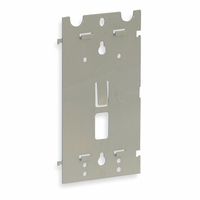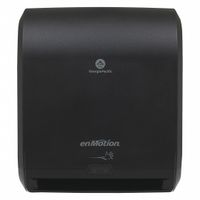Call +(254) 703 030 000 / 751 483 999 / 721 704 777
- Home
- Cleaning And Janitorial
- Paper Products Dispensers
- Paper Towels Dispensers
.....Read More
Frequently Asked Questions
What are the benefits of using paper towels over cloth rags?
Paper towels offer several benefits over cloth rags:
1. **Hygiene**: Paper towels are disposable, reducing the risk of cross-contamination. They are used once and discarded, which is particularly beneficial in environments where hygiene is critical, such as kitchens and bathrooms.
2. **Convenience**: They are readily available, easy to use, and require no maintenance. Unlike cloth rags, they do not need to be washed, dried, or stored, saving time and effort.
3. **Absorbency**: High-quality paper towels are designed to be highly absorbent, making them effective for quickly soaking up spills and messes. This can be more efficient than using cloth rags, which may require multiple uses to achieve the same result.
4. **Versatility**: Paper towels can be used for a variety of tasks, from cleaning surfaces to drying hands. They are suitable for both wet and dry applications, making them a versatile cleaning tool.
5. **Cost-Effectiveness**: While the initial cost of paper towels may seem higher, they can be more economical in the long run due to their single-use nature, eliminating the need for laundering and potential replacement of worn-out cloth rags.
6. **Availability**: Paper towels are widely available in various sizes and strengths, allowing users to choose the most appropriate type for their specific needs.
7. **Environmental Considerations**: Many paper towels are now made from recycled materials and are biodegradable, offering a more environmentally friendly option compared to synthetic cloth rags.
8. **No Residue**: Paper towels typically leave no lint or residue, ensuring a clean finish on surfaces, which is particularly important for glass and mirrors.
These benefits make paper towels a practical choice for many cleaning and drying tasks.
How do paper towels help in reducing cross-contamination?
Paper towels play a crucial role in reducing cross-contamination, particularly in environments like kitchens, hospitals, and public restrooms. They are single-use, which means they are disposed of after one use, minimizing the risk of transferring bacteria and viruses from one surface to another. When hands are washed, using a paper towel to dry them can remove additional bacteria that water alone might not eliminate. This is because the friction from the towel can physically dislodge microorganisms.
In contrast to cloth towels, which can harbor bacteria if not washed frequently, paper towels are discarded after use, ensuring that any pathogens they pick up are not spread further. They are also effective in cleaning spills, especially those involving raw meat or other potentially hazardous substances. By using a paper towel to clean such spills, and then disposing of it, the risk of spreading pathogens to other surfaces is significantly reduced.
Moreover, paper towels can be used to turn off faucets and open doors after handwashing, preventing recontamination of clean hands. This is particularly important in public restrooms, where high-touch surfaces can be breeding grounds for germs. By using a paper towel as a barrier, individuals can avoid direct contact with these surfaces.
In summary, paper towels help reduce cross-contamination by being single-use, effectively removing bacteria through friction, and serving as barriers against contaminated surfaces. Their disposability and convenience make them a practical choice for maintaining hygiene and preventing the spread of infectious agents.
Are paper towels more hygienic than cloth rags?
Paper towels are generally considered more hygienic than cloth rags for several reasons. Firstly, paper towels are single-use, which means they are disposed of after one use, reducing the risk of cross-contamination. In contrast, cloth rags are often reused multiple times, and if not properly sanitized between uses, they can harbor bacteria and other pathogens.
Secondly, paper towels are more effective at absorbing and removing bacteria from surfaces. Studies have shown that wiping surfaces with paper towels can significantly reduce the number of bacteria, whereas cloth rags may spread bacteria if they are not clean. The texture and absorbency of paper towels allow them to pick up and trap bacteria more effectively.
Additionally, paper towels are convenient and require no maintenance. They do not need to be washed or dried, unlike cloth rags, which require regular laundering at high temperatures to ensure they are free from bacteria. This laundering process can be time-consuming and may not always be done correctly, leading to the potential for bacterial growth.
However, it is important to note that the environmental impact of paper towels is a concern, as they contribute to waste and deforestation. Cloth rags, when properly maintained, are more sustainable and can be reused many times, reducing waste.
In conclusion, while paper towels are more hygienic due to their single-use nature and effectiveness in removing bacteria, cloth rags can be a more environmentally friendly option if they are properly cleaned and sanitized between uses. The choice between the two depends on the specific hygiene requirements and environmental considerations of the user.
What are the environmental impacts of using paper towels?
The environmental impacts of using paper towels are significant and multifaceted. Firstly, the production of paper towels involves deforestation, which contributes to habitat loss and biodiversity decline. Trees are a critical component of the ecosystem, and their removal disrupts wildlife habitats and reduces carbon sequestration, exacerbating climate change.
The manufacturing process of paper towels is resource-intensive, requiring large amounts of water and energy. The pulping process, which transforms wood into paper, often involves the use of chemicals like chlorine for bleaching, leading to the release of harmful pollutants into waterways. These pollutants can harm aquatic life and degrade water quality.
Transportation of paper towels from factories to consumers also contributes to carbon emissions, further impacting climate change. The packaging, often made from plastic, adds to the environmental burden, contributing to plastic pollution if not properly disposed of.
Once used, paper towels are typically discarded after a single use, leading to significant waste generation. In landfills, paper towels decompose and release methane, a potent greenhouse gas that contributes to global warming. Unlike other paper products, paper towels are often contaminated with food or cleaning agents, making them unsuitable for recycling and thus increasing landfill waste.
The environmental footprint of paper towels can be mitigated by opting for alternatives such as reusable cloth towels, which reduce the demand for single-use products and minimize waste. Additionally, choosing paper towels made from recycled materials or those certified by environmental organizations can help lessen their environmental impact.
How can I reduce waste when using paper towels?
To reduce waste when using paper towels, consider the following strategies:
1. **Use Sparingly**: Tear off only the amount you need. For small spills, a half or quarter sheet often suffices.
2. **Select-a-Size Rolls**: Purchase paper towels that offer perforated sections in smaller sizes, allowing you to use less per task.
3. **Reuse When Possible**: For light tasks, such as drying hands, reuse the towel if it's not too soiled.
4. **Opt for Reusable Alternatives**: Use cloth towels or rags for cleaning tasks. They can be washed and reused multiple times, significantly reducing paper towel consumption.
5. **Compost Used Towels**: If the paper towels are not contaminated with chemicals, compost them to reduce landfill waste.
6. **Choose Recycled Products**: Buy paper towels made from recycled materials to support sustainable practices.
7. **Implement Hand Dryers**: In bathrooms, use electric hand dryers instead of paper towels to eliminate waste.
8. **Educate and Encourage**: Inform family members or colleagues about the importance of reducing paper towel use and encourage them to adopt these practices.
9. **Store Wisely**: Keep paper towels out of immediate reach to discourage overuse. Place them in a less convenient location to make users think twice before grabbing one.
10. **Use Efficiently**: Fold the towel to increase absorbency and use both sides to maximize its utility.
11. **DIY Cleaning Cloths**: Cut old clothes or linens into rags for cleaning purposes, reducing the need for paper towels.
By adopting these practices, you can significantly reduce paper towel waste, contributing to environmental conservation and promoting sustainable habits.
What are the different types of paper towel dispensers available?
There are several types of paper towel dispensers available, each designed to meet different needs and preferences:
1. **Manual Dispensers**: These require users to pull the paper towels manually. They are cost-effective and simple, with no need for batteries or electricity. Variants include lever-operated and center-pull dispensers.
2. **Automatic Dispensers**: These use sensors to dispense paper towels, offering a touchless experience that enhances hygiene. They are battery or electricity-powered and are ideal for high-traffic areas.
3. **Center-Pull Dispensers**: These dispense paper towels from the center of the roll, reducing waste and ensuring single-sheet dispensing. They are compact and suitable for smaller spaces.
4. **Folded Towel Dispensers**: Designed for C-fold, Z-fold, or multifold towels, these dispensers allow users to pull one towel at a time, minimizing waste and maintaining hygiene.
5. **Roll Towel Dispensers**: These accommodate large rolls of paper towels, making them suitable for high-traffic areas. They can be manual or automatic, with options for controlled dispensing to reduce waste.
6. **Recessed Dispensers**: Installed into walls, these dispensers save space and provide a sleek look. They are often used in commercial restrooms for a clean and modern appearance.
7. **Countertop Dispensers**: Portable and easy to refill, these are ideal for kitchens or areas with limited wall space. They are typically used for folded towels.
8. **Combination Units**: These integrate paper towel dispensers with waste receptacles or other restroom accessories, optimizing space and functionality.
Each type of dispenser offers unique benefits, catering to different environments and user preferences, from high-traffic public restrooms to private kitchens.
How do automatic paper towel dispensers work?
Automatic paper towel dispensers operate using sensors and a motorized mechanism to dispense paper towels without physical contact. These dispensers typically use infrared sensors to detect the presence of a hand. When a hand is placed near the sensor, it detects the infrared light reflected back from the hand, triggering the dispenser to activate.
Once the sensor is activated, it sends a signal to a small motor inside the dispenser. This motor is connected to a roller mechanism that holds the roll of paper towels. The motor turns the roller, which pulls the paper towel from the roll and feeds it through a slot, cutting it to a predetermined length. The cutting mechanism can be a serrated edge or a blade that ensures a clean tear.
The dispensers are powered by batteries or an electrical connection, depending on the model. Battery-powered dispensers are more common in locations where electrical outlets are not conveniently available. The design of these dispensers often includes features to adjust the length of the paper towel dispensed, the sensitivity of the sensor, and the delay between dispensing actions to conserve paper and energy.
Some advanced models incorporate additional features such as adjustable dispensing speeds, low-paper indicators, and jam-prevention mechanisms. These features enhance user experience and reduce maintenance needs. The touchless operation of automatic paper towel dispensers promotes hygiene by minimizing the spread of germs, making them popular in public restrooms and other high-traffic areas.


